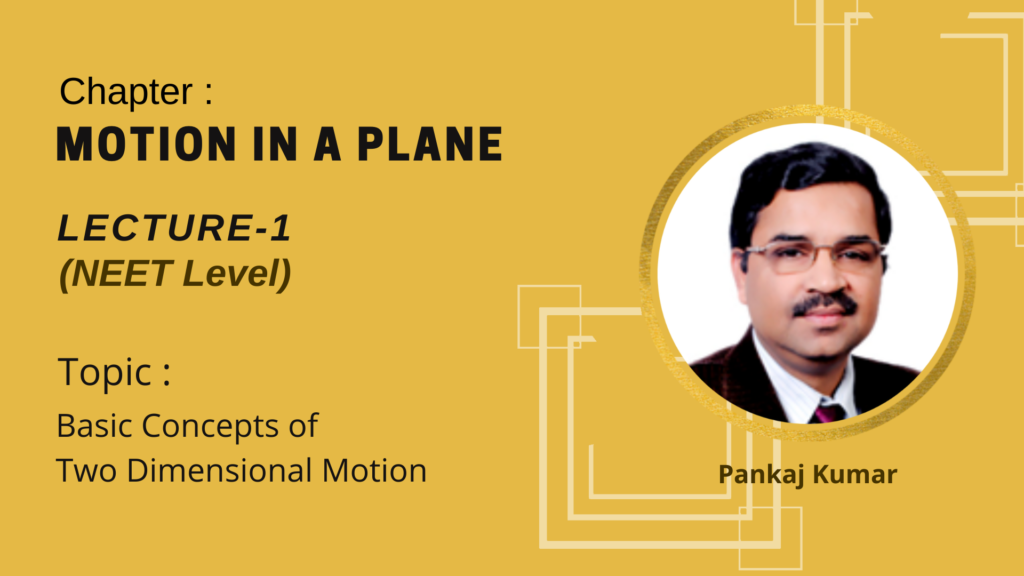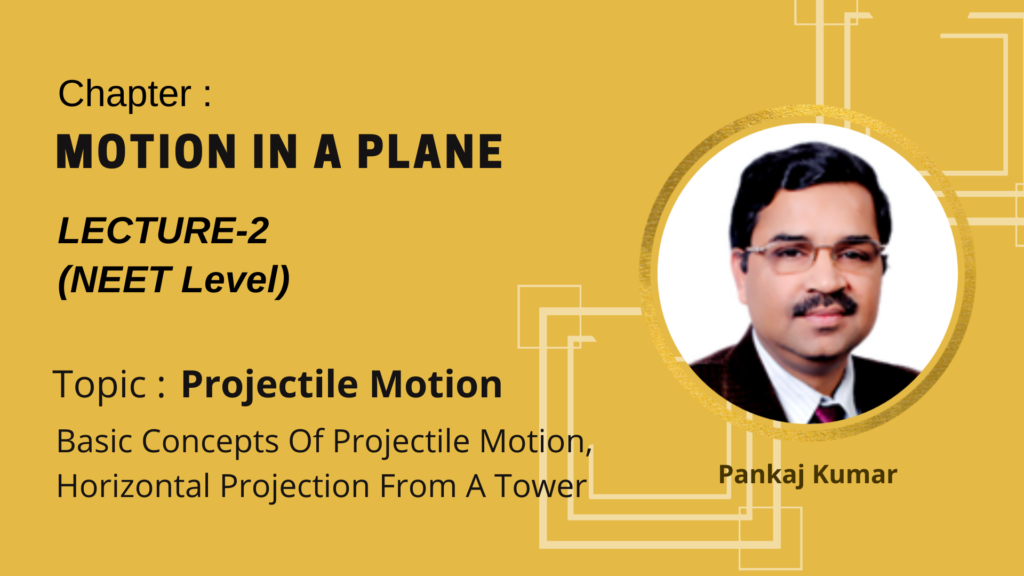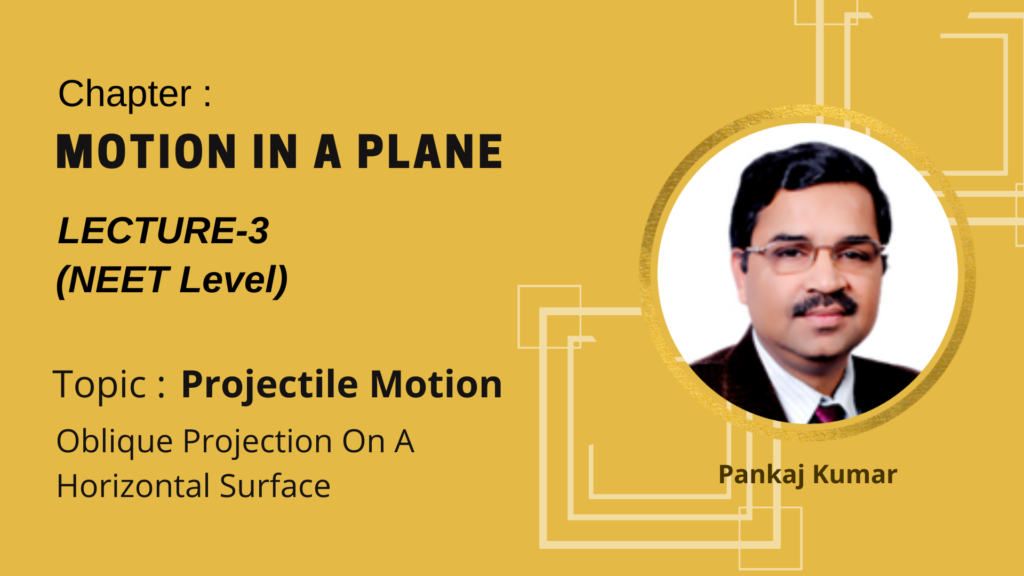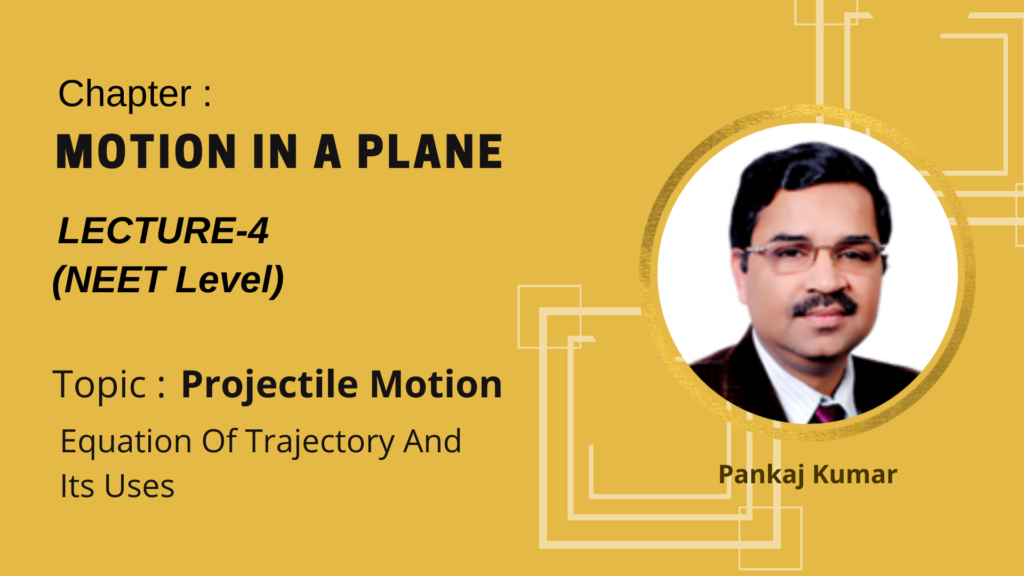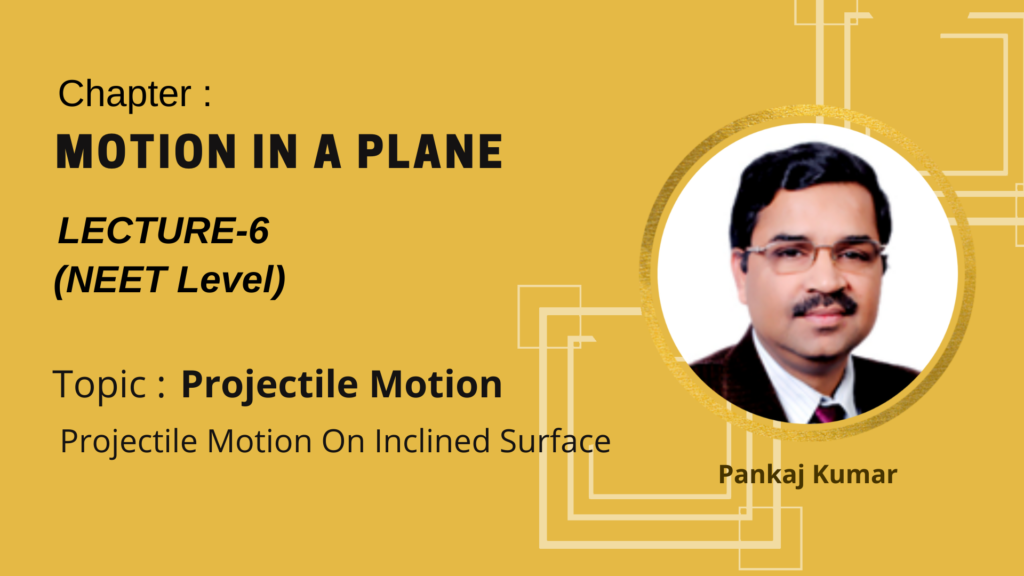Video Lectures
Theory For Making Notes
Introduction
An object launched with certain initial velocity and following a curved path under the gravitational field of earth alone is called projectile and its motion is called projectile motion. This definition includes the effect of air resistance, rotation and curvature of the earth and the variation of acceleration due to gravity of the earth.
Generally the projectile motion of body near earth surface is approximated by assuming body as a point particle moving under the field of earth having constant value of g and following a parabolic path in the absence of air resistance, rotation and curvature effect of earth.
Note that
the motion of projectile is two-dimensional motion contained in a plane having and initial velocity vector of projection. And the motion of projectile can be represented as superposition of the uniform horizontal motion and the uniform accelerated vertical motion.
Analysis of Projectile Motion
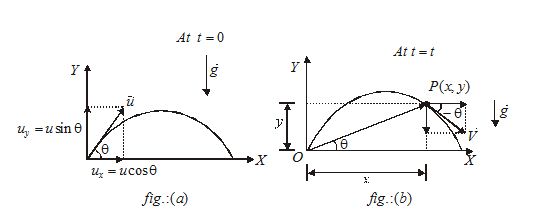
Consider a projectile is launched from the origin of rectangular coordinate system, having x-axis parallel to horizon and y-axis perpendicular to the ground, with initial velocity making an angle θ with the x-axis or with horizon as shown in figure (a). As discussed, the motion of projectile is uniform motion along x–axis and uniform accelerated motion, of acceleration \vec{g}=-g\hat{j}, along the y–axis, so the equations of motion of the projectile at an instant of time , as shown in figure (b), are given as

Time of flight (T)
It is the time taken by projectile to move from the point of launching to the point of landing. Thus, t = T, when y = 0. From the second equation of motion for y-axis, we get
0=u\sin \theta \,\,t-\frac{1}{2}g{{t}^{2}}
t = 0 or t=\frac{{2u\sin \theta }}{g}
Here, t = 0 is at an instant of launching and t=\frac{{2u\sin \theta }}{g} at an instant of landing
Thus time of flight T=\frac{{2u\sin \theta }}{g}.
Equation of Trajectory
The path followed by the projectile is called its trajectory. Mathematically it is defined as a function . Thus, from the second equation of motion, by eliminating t we get
y=(u\sin \theta )\left( {\frac{x}{{u\cos \theta }}} \right)-\frac{1}{2}g{{\left( {\frac{x}{{u\cos \theta }}} \right)}^{2}}
or y=x\tan \theta -\frac{{g{{x}^{2}}}}{{{{u}^{2}}{{{\cos }}^{2}}\theta }}
This is an equation of a parabola of the type y=ax-b{{x}^{2}}.
Thus the trajectory of projectile is a parabola in the absence of air resistance, rotation and curvature effect of the earth.
Calculation Of Range & Maximum Height From Equation Of trajectory
Range (R):It is the horizontal distance covered by particle from the point of projection to the point of landing. Thus when .
From the equation of trajectory, we get
0=R\tan \theta -\frac{1}{2}\frac{{g{{R}^{2}}}}{{{{u}^{2}}{{{\cos }}^{2}}\theta }}
R=\frac{{2{{u}^{2}}\sin \theta \cos \theta }}{g}=\frac{{{{u}^{2}}\sin 2\theta }}{g}
Note that the range R is maximum when projectile is projected at an angle 45° .
{{R}_{{\max }}}=\frac{{{{u}^{2}}\sin (2\times 45{}^\circ )}}{g}=\frac{{{{u}^{2}}\sin 90{}^\circ }}{g}=\frac{{{{u}^{2}}}}{g}
III. Maximum Height (H):It is the highest distance of projectile above the ground in its trajectory.
Thus y=H when {{v}_{y}}=0. From the third equation of motion for y–axis, we get
0={{(u\sin \theta )}^{2}}-gH H=\frac{{{{u}^{2}}{{{\sin }}^{2}}\theta }}{g}
Important Points
In projectile motion, the time required to reach maximum height from the point of projection on horizontal ground is equal to the time required to return back on the ground i.e., the time of ascent is equal to the time of descent thus,
{{t}_{a}}={{t}_{d}}=\frac{T}{2}=\frac{{u\sin \theta }}{g}
The velocity of projectile at the highest point has only horizontal component i.e., at the highest point
{{v}_{y}}=0 and {{v}_{x}}=u\cos \theta
Therefore, \overset{\to }{\mathop{v}}\,=u\cos \,\theta \,\hat{i}
When the projectile strike the ground, then
{{v}_{x}}=u\cos \theta and {{v}_{y}}=u\sin \theta -g\left( {\frac{{2u\sin \theta }}{g}} \right)=-u\sin \theta
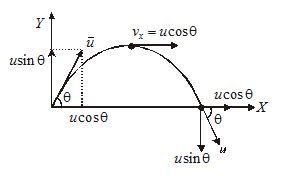
Therefore, \overset{\to }{\mathop{v}}\,=u\cos \theta \,\,\hat{i}-u\sin \theta \,\,\hat{j} and |\overset{\to }{\mathop{v}}\,|=u
Thus the projectile hit ground with the same speed with which it was projected and it makes same angle but below the horizon as shown in figure.
Relation between R, H and T
(i) R=4H\cot \theta
(ii) T=2\sqrt{{2gH}}
(iii) R=\frac{1}{2}g{{T}^{2}}\cot \theta
Properties of complimentary angles of projection
(i)
The horizontal ranges are equal for complementary angles of projections
Let {{\theta }_{1}} and {{\theta }_{2}} are the two angles of projection such that
{{\theta }_{1}}+{{\theta }_{2}}=90{}^\circ .
Then,
{{R}_{1}}=\frac{{{{u}^{2}}\sin 2{{\theta }_{1}}}}{g}=\frac{{2{{u}^{2}}\sin {{\theta }_{1}}\cos {{\theta }_{1}}}}{g} =\frac{{2{{u}^{2}}\cos {{\theta }_{2}}\sin {{\theta }_{2}}}}{g} ( {{\theta }_{1}}=90{}^\circ -{{\theta }_{2}})
{{R}_{1}}={{R}_{2}}
(ii)
The complementary angles are symmetrically located about an angle 45{}^\circ i.e., if
{{\theta }_{1}}=45{}^\circ +\alpha , then {{\theta }_{2}}=45{}^\circ -\alpha
(iii)
For complementary angles of projection, e.g., and 90-\theta , the ratio of the maximum heights attained is equal to 90-\theta and sum of these heights is equal to \frac{{{{u}^{2}}}}{{2g}}.
Let and are the maximum heights for and 90-\theta angles of projection, then
{{H}_{1}}=\frac{{{{u}^{2}}{{{\sin }}^{2}}\theta }}{{2g}}and {{H}_{2}}=\frac{{{{u}^{2}}{{{\sin }}^{2}}(90-\theta )}}{{2g}}=\frac{{{{u}^{2}}{{{\cos }}^{2}}\theta }}{{2g}}
Therefore \frac{{{{H}_{1}}}}{{{{H}_{2}}}}=\frac{{{{{\sin }}^{2}}\theta }}{{{{{\cos }}^{2}}\theta }}={{\tan }^{2}}\theta
and {{H}_{1}}+{{H}_{2}}=\frac{{{{u}^{2}}}}{{2g}}({{\sin }^{2}}\theta +{{\cos }^{2}}\theta )=\frac{{{{u}^{2}}}}{{2g}}
(iv)
For complimentary angles of projection, product of the times of flight is proportional to their common range.
Let {{T}_{1}} and {{T}_{2}} are the time of flight for angle of projections \theta and 90-\theta , then
{{T}_{1}}=\frac{{2u\sin \theta }}{g}and {{T}_{2}}=\frac{{2u\sin (90-\theta )}}{g}=\frac{{2u\cos \theta }}{g}
Therefore,
{{T}_{1}}\,\,{{T}_{2}}=\left( {\frac{{2u\sin \theta }}{g}} \right)\left( {\frac{{2u\cos \theta }}{g}} \right) =\frac{2}{g}\left( {\frac{{{{u}^{2}}\sin 2\theta }}{g}} \right)=\frac{2}{g}R or {{T}_{1}}\,{{T}_{2}}\propto R
The equation of trajectory can be written in terms of range R as
y=x\tan \theta \left( {1-\frac{x}{R}} \right)
Effect of air resistance
In presence of air resistance, range, maximum height attained, time of ascent and flight reduces but time of decent and angle of landing increases.
Projectile Motion on an Inclined Plane
Suppose a projectile is thrown at an angle a to the horizontal with a speed u on a plane which makes an angle b to the horizontal. We wish to find the distance traveled on the plane by the projectile. For this purpose, we choose a reference frame as shown in the figure.
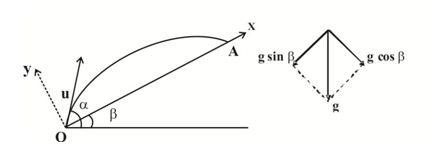
Now, we resolve the motion into two parts,
ux= u cos (α – β)
uy= u sin ((α – β)
ax= –g sin β
ay= –g cos β
Note that the y–component of the displacement is zero in traveling from O to A. Thus using
sy = uyt + \displaystyle \frac{1}{2}{{a}_{y}}{{t}^{2}}
we have 0 = u sin ((α – β)t + \displaystyle \frac{1}{2} (-g cos b) t2 giving us t = \displaystyle \frac{{2u\sin \left( {\alpha -\beta } \right)}}{{g\cos \beta }}
Next using sx = uxt + \displaystyle \frac{1}{2}axt2
OA = u cos ((α – β) t + \displaystyle \frac{1}{2} (-g sin β) t2
Putting the value of t obtained earlier, we have
OA = \displaystyle \frac{{2{{u}^{2}}\cos \alpha \sin \left( {\alpha -\beta } \right)}}{{g{{{\cos }}^{2}}\beta }}
or OA = \displaystyle \frac{{{{u}^{2}}}}{{g{{{\cos }}^{2}}\beta }} [sin(2(α – β) – sinb]
This is the required expression for range on an inclined plane. It will be maximum when
sin (2(α – β) = 1 or (α = 1/2(β + π /2)
Rmax= \displaystyle \frac{{{{u}^{2}}\left( {1-\sin \beta } \right)}}{{g\left( {1-{{{\sin }}^{2}}\beta } \right)}}=\frac{{{{u}^{2}}}}{{g\left( {1+\sin \beta } \right)}}
Illustration
A ball is projected horizontally at 20 m/s from a cliff of height 45 m
(a) Find its time of flight
(b) Find its horizontal range R (the horizontal displacement from the point of firing).
Solution
The origin is assumed to be at the base of the cliff
Given: xo=0; yo= 45 m; vox= 20 m/s and voy= 0
The coordinates at a latter time are given by
x = 20 t … (i)
x = 45 – 5t2 … (ii)
(a) When the ball lands, its vertical coordinate is zero
i.e. y = 0 From (ii) , we get
y = 45 – 5t2 or t = 3 s
(b) To find the horizontal range we use the horizontal velocity and the time of flight.
R = voxt = (20) (3) = 60 m
Illustration
Find the average velocity of a projectile between the instants it crosses one third the maximum height. It is projected with u making an angle q with the vertical.
(a) u cos q
(b) u
(c) u sin q
(d) u tan q
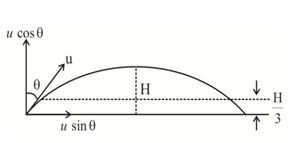
Solution
Note carefully the vertical velocities at the same height are in opposite direction and therefore their average sum = 0. It is horizontal velocity which is uniform and hence vav = u sin θ( = ux)
Illustration
A person observes a bird on a tree 40 m high and at a distance of 60 m. With what velocity the person should throw an arrow at an angle of 45o so that it may hit the bird? g = 10 m/s2.
Solution
Let u be the initial velocity of the arrow and let it hit the bird after t.
The horizontal component of velocity u is u cos 45o = \frac{u}{{\sqrt{2}}}. Hence the horizontal distance traveled in t s is \frac{u}{{\sqrt{2}}}x t = 60 … (1)
The vertical distance traveled in time t s is 40 m, acceleration g = – 10 m/s2 and initial vertical velocity = u sin 45o = \frac{u}{{\sqrt{2}}}. Hence by the formula h = ut + \displaystyle \frac{1}{2}gt2, we have
40 = \displaystyle \frac{u}{{\sqrt{2}}}t-\frac{1}{2}\left( {10} \right){{t}^{2}} … (2)
By equation (1) and (2), we get
40 = 60 – \displaystyle \frac{1}{2}\left( {10} \right){{t}^{2}}
or t2 = \displaystyle \frac{{60-40}}{5}=\frac{{20}}{5}=4
t = 2 s
Substituting the value of t in equation (1), we get
\frac{u}{{\sqrt{2}}}´ 2 = 60
u = 30 \displaystyle \sqrt{2} m/s
Illustration
A bomb is fired from a cannon with a velocity of 1000 m/s making an angle of 30o with the horizontal (g = 10 m/s2).
(i) What is the time taken by the bomb to reach the highest point?
(ii) What is the total time of its motion ?
(iii) With what speed the bomb will hit the ground and what will be its direction of motion while hitting?
(iv) What is the maximum height attained by the bomb?
(v) At what distance from the cannon the bomb will hit the ground ?
Solution
(i) Let u be the initial velocity of the bomb and qo its angle of projection. The time taken by the bomb to reach the highest point is given by
t = \displaystyle \frac{{u\sin {{\theta }_{o}}}}{g}=\frac{{1000\times \sin 30{}^\circ }}{{10}}=\frac{{1000\times \frac{1}{2}}}{{10}} = 51 s
(ii) The total time of its motion is, T = 2t = 2 x 51 = 102 s.
(iii) The bomb will hit the ground with the same speed with which it was fired. Hence its speed of hitting = 1000 m/s. Also, the angle of hitting with respect to the horizontal is 30o.
(iv) The maximum height attained by the bomb is
h = \displaystyle \frac{{{{u}^{2}}{{{\sin }}^{2}}{{\theta }_{o}}}}{{2g}}
= \displaystyle \frac{{{{{\left( {1000} \right)}}^{2}}\times {{{\sin }}^{2}}{{{30}}^{o}}}}{{2\times 10}}=\frac{{{{{\left( {1000} \right)}}^{2}}\times {{{\left( {0.5} \right)}}^{2}}}}{{2\times 10}} =1.25 x 104 m
(v) Horizontal range is
R = \displaystyle \frac{{{{u}^{2}}\sin 2{{\theta }_{o}}}}{g}=\frac{{{{{\left( {1000} \right)}}^{2}}\times \sin {{{60}}^{o}}}}{{10}} = 8.66 x 104 m
Illustration
A ball is thrown from the top of a tower with an initial velocity of 10 m/s at an angle of 30o with the horizontal. It hits the ground at a distance of 17.3 m from the base of the tower. Calculate the height of the tower. (g = 10 m/s2)
Solution
The angle of projection of the ball is qo (=30o) and the velocity of projection is u (= 10 m/s). Resolving u in horizontal and vertical components, we have horizontal component,
ux= u cos qo = 10 cos 30o = 8.65 m/s
and vertical component (upward), uy= u sin30o = 5 m/s.

f the ball hits the ground after time t of projection, then the horizontal range is
R = ux X t = 8.65 t m
t = \displaystyle \frac{R}{{8.65}}=\frac{{17.3}}{{8.65}} = 2 s
If h be the height of the tower, then
h = uyt + \frac{1}{2}gt2
Here uy= 5 m/s , t = 2 s and g = -10m/s2
h = (5) x 2 + 1/2 x (-10) x (2)2 = 10 – 20 = – 10 m
The negative sign shows that the displacement is negative (downward).
Thus the height of the tower = 10 m
Illustration
A foot ball is kicked with a velocity of 20 m/s at an angle of 45° with the horizontal. (a) Find the time taken by the ball to strike the ground, (b) Find the maximum height it reaches. (c) How far away from the kick does it hit the ground? Take g = 10 m/s2.
Solution
(a) Take the origin at the point where the ball is kicked, vertically upward as the Y-axis and the horizontal in the plane of motion as the X-axis. The initial velocity has the components
\displaystyle {{u}_{x}}=(20\text{m/s})\cos 45{}^\circ =10\sqrt{2}\text{m/s}
& \displaystyle {{u}_{y}}=(20\text{m/s})\sin 45{}^\circ =10\sqrt{2}\text{m/s}
When the ball reaches the ground, y = 0.
Using \displaystyle y={{u}_{y}}t-\frac{1}{2}g{{t}^{2}}
\displaystyle 0=(10\sqrt{2}\text{m/s})t-\frac{1}{2}\times (10\,\text{m/}{{\text{s}}^{2}})\times {{t}^{2}}
or, \displaystyle t=2\sqrt{2}s=2.8s.
Thus, it takes 2.8s for the football to fall on the ground
(b) At the highest point Using the equation
\displaystyle v_{y}^{2}=u_{y}^{2}-2gy,
\displaystyle 0={{(10\sqrt{2}\text{m/s})}^{2}}-2\times (10\text{m/}{{\text{s}}^{2}})H
or, H = 10m.
Thus, the maximum height reached is 10 m.
(c) The horizontal distance traveled before falling to the ground is
x = uxt
x = \displaystyle (10\sqrt{2}\text{m/s})\,\,(2\sqrt{2}\text{s})=40\text{m}
Illustration
A ball is projected with velocity v0 and at an angle of projection a. After what time is the ball moving at right angles to the initial direction?
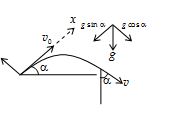
Solution
We choose x-axis along the initial velocity. If after time t the velocity is perpendicular to initial direction, vx must be zero after time t,
i.e. \displaystyle 0={{v}_{0}}-(g\sin \alpha )t
or \displaystyle t=\frac{{{{v}_{0}}}}{{g\sin \alpha }}
Practice Questions (Level-1)
1.
Which of the following is the largest when the height attained by projectile is the greatest?
(a) Angle of projectile with the vertical (b) Range
(c) Time of light (d) None of these
Ans (b)
2.
A projectile is thrown to have the maximum possible horizontal range of 400 m. Taking the point of projection as the origin, the co-ordinate of the point where the velocity of the projectile is minimum are
(a) (400m, 200m) (b) (200m, 200m)
(c) (400m, 100m) (d) (200m, 100m)
Ans (d)
3.
In case of a projectile, what is the angle between its instantaneous velocity and acceleration at the highest point?
(a) 180° (b) 90° (c) 45° (d) 0°
Ans (b)
4.
The range of a projectile when fired at 75° with the horizontal is 0.5 km. What will be its range when fired at 45°?
(a) 2 km (b) 1.5 km (c) 1 km (d) 0.5 km
Ans (c)
5.
If a man wants to hit a target, he should aim his rifle in a direction:
(a) Lower than the target (b) Of the target
(c) Higher than the target (d) None of these
Ans (c)
6.
The x and y coordinates of a particle at any time t are given by x=7t+4{{t}^{2}} and y=5t where x and y are in metre and t in second. The acceleration of the particle at t=5s is
(a) \mathbf{40}\,\mathbf{m}{{\mathbf{s}}^{{-\mathbf{2}}}} (b) 20\,\mathbf{m}{{\mathbf{s}}^{{-\mathbf{2}}}} (c) \mathbf{8}\,\,\mathbf{m}{{\mathbf{s}}^{{-\mathbf{2}}}} (d) Zero
Ans (c)
7.
The coordinate of a moving particle at any instant of time t are x= at and y=b{{t}^{2}}. The trajectory of the particle is
(a) y=\frac{{{{b}^{2}}x}}{{{{a}^{2}}}} (b) y=\frac{{{{b}^{2}}{{x}^{2}}}}{{{{a}^{2}}}} (c) {{y}^{2}}=\frac{{{{b}^{2}}x}}{{{{a}^{2}}}} (d) y=\frac{{b{{x}^{2}}}}{{{{a}^{2}}}}
Ans (d)
8.
The equation of motion of a projectile is y=12x-\frac{3}{4}{{x}^{2}}. What is the range of the projectile?
(a) 3m (b) 4m (c) 12m (d) 16m
Ans (c)
9.
A passenger traveling in a train, which is moving with constant velocity, drops a stone from the window. To the passenger, the path of projectile will appear to be:
(a) An arc of a circle (b) An elliptical (c) A straight line (d) A parabola.
Ans (c)
10.
Two projectiles are fired at different angles with the same magnitude of velocity such that they have the same range. At what angles they might have been projected?
(a) 35° and 75° (b) 25° and 65° (c) 10° and 50° (d) None of these
Ans (b)
11.
Four projectiles are fired with the same speed at the angles 25°, 40°, 55° and 70° with the horizontal. The range of projectile will be largest for the one projected at an angle
(a) 70° (b) 40° (c) 55° (d) 25°
Ans (b)
12.
From the top of a tower, which is 19.6 m high, a ball is thrown horizontally. If the line joining the point of projection to the point where it hits the ground makes an angle of 45° with the horizontal, then the initial velocity of the ball is
(a) 9.8 m/s (b) 4.9 m/s (c) 14.7 m/s (d) 2.8 m/s
Ans (a)
13.
The pervious question, the magnitude of the velocity of ball when it collide with the ground is
(a)9.8m/s (b) 9.8\sqrt{3}\,\mathbf{m/s} (c) 19.6 m/s (d) 9.8\sqrt{5}\,\mathbf{m/s}
Ans (d)
14.
An aero-plane is moving horizontally with a velocity of magnitude u. It drops a packet when it is at a height h. The time taken by the packet to reach the ground is
(a) \sqrt{{\frac{{2u}}{g}}} (b) \sqrt{{\frac{{2g}}{h}}} (c) \sqrt{{\frac{u}{{2g}}}} (d) \sqrt{{\frac{{2h}}{g}}}
Ans
Practice Questions (Level-2)
1.
If projectile is thrown in a viscous medium offering resistance equal to one-tenth of the acceleration due to gravity, the time of flight of projectile will
(a) increase by 1% (b) decrease by 1%
(c) increase by 2% (d) decrease by 2%
Ans (c)
2.
A ball thrown by one player reaches the other in 2 second. The maximum height attained by the ball above the point of projection is about
(a) 10 m (b) 7.5 m (c) 5 m (d) 2.5 m
Ans (c)
3.
Two stones are projected with the same speed but making different angles with the horizontal. Their ranges are equal. If the angle of projection of one is and its maximum height is , then the maximum height of the other is
(a) {{y}_{1}}/2 (b) {{y}_{1}}/3 (c) 3{{y}_{1}} (d) 2{{y}_{1}}
Ans (b)
4.
Two bullets are fired at angles and to the horizontal with the same speed. The ratio of their times of flight is
(a) 1:\tan \theta (b) {{\tan }^{2}}\theta :1 (c) 1:1 (d) \tan \theta :1
Ans (d)
5.
If a particle moves according to the equation y=x-\frac{{{{x}^{2}}}}{2}, then the maximum height reached by the particle is
(a) 1 m (b) 1/3 m (c) 1/2 m (d) 1/4 m
Ans (c)
6.
A particle is projected at an angle of 30° with the horizon. The time corresponding to height h while ascending and while descending are and respectively. The speed of projection of particle is
(a) g({{t}_{1}}+{{t}_{2}}) (b) \frac{{g({{t}_{1}}+{{t}_{2}})}}{2} (c) g{{t}_{1}} (d) g{{t}_{2}}
Ans (b)
7.
Two parallel buildings are x distance apart. A boy throws a ball horizontally with from one of the building which fall 10 m below in the opposite building. Then the value of x is
(a) 20 m (b) 10 m (c) 10\sqrt{2}\,\,\mathbf{m} (d) 10\sqrt{3}\,\,\mathbf{m}
Ans (c)
8.
Two particles A and B are projected from the ground toward each other with speeds 10m/s and 6\sqrt{2}\,\mathbf{m/s} respectively. They are projected at angles 37° and 45°, respectively, with horizontal direction from two points separated by a distance of 9.8 m. How much time will they take to collide?
(a) 0.7s (b) 1.2s (c) 1.4s (d) 1.5s
Ans (a)
9.
In previous question, at what height from the ground both particles will collide?
(a) 151 cm (b) 430 cm (c) 22.5 cm (d) 180 cm
Ans.(d)
10.
A projectile is required to hit a target whose coordinates relative to horizontal and vertical axes through the point of projection are (\alpha ,\beta ). If the gun velocity is \sqrt{{2g\alpha }}, it is impossible to hit the target if
(a) \beta \le \frac{3}{4}\alpha (b) \beta \ge \frac{4}{3}\alpha (c) \beta >\frac{3}{4}\alpha (d) \beta \ge \frac{1}{4}\alpha
Ans (a)
11.
A ball rolls from the top of a stair case with a horizontal velocity . The steps are h in height and b in wide. The ball will hit the edge of the nth step if
(a) n=\frac{{2h{{u}^{2}}}}{{gb}} (b) n=\frac{{h{{u}^{2}}}}{{g{{b}^{2}}}} (c) n=\frac{{2hu}}{{g{{b}^{2}}}} (d) n=\frac{{2h{{u}^{2}}}}{{g{{b}^{2}}}}
Ans (d)
12.
A number of bullets are fired in all possible directions with the same initial velocities each of magnitude u. The maximum area of the ground covered by bullets is
(a) \pi {{\left( {\frac{{{{u}^{2}}}}{g}} \right)}^{2}} (b) \pi {{\left( {\frac{{{{u}^{2}}}}{{2g}}} \right)}^{2}} (c) \pi {{\left( {\frac{u}{g}} \right)}^{2}} (d) \pi {{\left( {\frac{u}{{2g}}} \right)}^{2}}
Ans (a)
13.
A particle is moving in x-y plane. At certain instant of time, the components of its velocity and acceleration are as follows {{v}_{x}}=3\,\mathbf{m/s}, {{v}_{y}}=4\,\mathbf{m/s}, {{a}_{x}}=2\,\mathbf{m/}{{\mathbf{s}}^{\mathbf{2}}} and {{a}_{y}}=1\,\mathbf{m/}{{\mathbf{s}}^{\mathbf{2}}}. The rate of change of speed at this moment is
(a) \sqrt{{10}}\,\mathbf{m/}{{\mathbf{s}}^{\mathbf{2}}} (b) 4\,\mathbf{m/}{{\mathbf{s}}^{\mathbf{2}}} (c) \sqrt{5}\,\mathbf{m/}{{\mathbf{s}}^{\mathbf{2}}} (d) 2\,\mathbf{m/}{{\mathbf{s}}^{\mathbf{2}}}
Ans. (d)
14.
If the maximum height attained by a projectile is increased by 5% keeping angle of projection constant, the percentage increase in range is
(a) 5% (b) 10% (c) 15% (d) 20%
Ans. (a)
15.
The vertical height of the projectile at time t is given by y=4t-{{t}^{2}}, and the horizontal distance covered is given by . What is the angle of projection with the horizontal?
(a) {{\tan }^{{-1}}}\frac{3}{5} (b) {{\tan }^{{-1}}}\frac{4}{5} (c) {{\tan }^{{-1}}}\frac{4}{3} (d) {{\tan }^{{-1}}}\frac{4}{3}
Ans (c)
16.
A gun shoots bullets that leave the muzzle at 250 m/s. If the bullet is to hit a target 100 m away at the level of the muzzle, the gun must be aimed at a point above the target. How far above the target is this point.
(a) 100 cm
(b) 80 cm
(c) 75 cm
(d) 50 cm
Ans (b)
17.
A particle is projected at the angle (45° – q) and another at (45° + q). They land at the level from which they were fired. Find the difference in their times of flight if the speed of projection in each case is v0.
(a) 8\sqrt{2}\frac{{{{v}_{o}}\sin \theta }}{g}
(b) 5\sqrt{2}\frac{{{{v}_{o}}\sin \theta }}{g}
(c) 2\sqrt{2}\frac{{{{v}_{o}}\sin \theta }}{g}
(d) 3\sqrt{3}\frac{{{{v}_{o}}\sin \theta }}{g}
Ans (c)
18.
For a given horizontal range, less than the maximum, there are two possible projection angles, \displaystyle \theta 1 and \displaystyle \theta 2. If \displaystyle \theta 1< \displaystyle \theta 2. then the ratio of the time of flight is
(a) $latex \tan {{\theta }_{1}}$
(b) $latex \sin {{\theta }_{1}}$
(c) $latex \cot {{\theta }_{1}}$
(d) $latex \sec {{\theta }_{1}}$
Ans (a)

